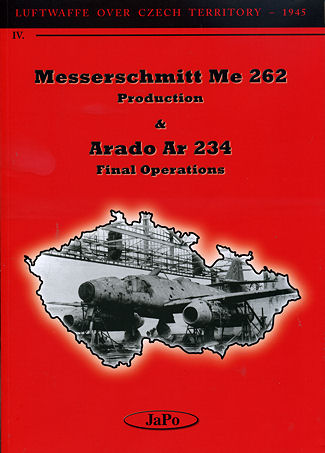 Those
who are familiar with JaPo books know two things about them. First is they are
superbly researched and are often the best that has been published on that
particular subject. The second is that they sell out rather quickly once
produced. I'm sorry to have missed the first two books in this series.
Those
who are familiar with JaPo books know two things about them. First is they are
superbly researched and are often the best that has been published on that
particular subject. The second is that they sell out rather quickly once
produced. I'm sorry to have missed the first two books in this series.
This is their fourth book on the Luftwaffe over Czech Territory in 1945 and
covers Messerschmitt Me-262 production/assembly as well as the final
operations of the Ar-234. All of this covers the area known as Bohemia, an area
in western Czechoslovakia that was predominately settled by folks of German
origin.
Production/assembly of the Me-262 took place at two
specific locations. One was the Fugzeugwerks Eger Gmbh (FWE) complex in Cheb.
This was a state of the art factory that was based on all the best features of
other aircraft factories in Germany. It was started in 1940 and by 1942, it was
ready to go. It concentrated on the production of components for the He-111 as
well as the repair and upgrading of the He-177. By late 1944 all work on bombers
had been shelved with concentration on fighters so it was switched over to
Me-262 assembly and repair.
By this late in the war, assembly was more of the state
of the aircraft industry as components for planes were scattered all over the
shrinking Reich and then transported to a final assembly location like FWE. At
FWE, the main focus was on the recce 262 and most of the production of the
Me-262A-3 was concentrated there.
The other place was Leichtbau Gmbh (LBB) established at
Ceske Budejovice (Budweis). It initially was involved in the production and
repair of the Fi-156 and FW-190, but in mid 1944 was converted to the Me-262,
though no assembly/production occurred until six months after conversion was
started. This facility concentrated on fighter production and like FWE, also
repaired the 262.
Typical of JaPo books, the information provided is
extensive and in addition to a superbly researched background to each of the
facilities, contains a superb selection of data regarding just what was built
and repaired at these places. We expect there to be information on specific
aircraft and that is what we get. In fact, I would say that half the book is
dedicated to this aspect of things. It includes large four views of various
aircraft with each plane accompanies by what is probably all of the know images
of the planes in question. Of course, many of these are of the aircraft in the
dump at the end of the war, but not all, including several period color images.
In addition, there is information on Ar-234 final
operations in this area during the last months of the war. These were mostly
recce units, though there were prototypes of the Ar-234C four engine aircraft
included. The photos and color views concentrate on this particular variant.
Also included in the book is an errata section updating information from their
previous 262 book. Included in this section are images and color views of the
Me-262v11, with the clear bomber nose. Another nice addition is information and
color views on a Bf-109K-4 from JG 27 that performed airfield defense for the
262s. A well done appendix focuses on the installation of the 30mm Mk108 in the
recce 262. Not many were built with this single cannon installation, but it did
provide some self defense other than speed.
This is a book that takes time to read. The information
is quite extensive and it took me several weeks to read through it. Perhaps not
for the light reader, but if you are interested in the details, then this is
very much a book that you must have. I give it my highest recommendation and
suggest that you get yours while the getting is good as it won't be out there
for long.
October 2012
Review book courtesy of JaPo. Visit them at
www.japo.eu and ask
for this one at your favorite book seller
If you would like your product reviewed fairly and quickly, please
contact
me or see other details in the
Note to
Contributors.
Back to the Book Index
Back to the Main Page
 Those
who are familiar with JaPo books know two things about them. First is they are
superbly researched and are often the best that has been published on that
particular subject. The second is that they sell out rather quickly once
produced. I'm sorry to have missed the first two books in this series.
Those
who are familiar with JaPo books know two things about them. First is they are
superbly researched and are often the best that has been published on that
particular subject. The second is that they sell out rather quickly once
produced. I'm sorry to have missed the first two books in this series.